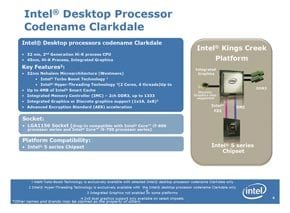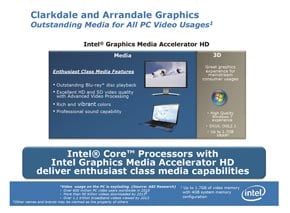Intel 32nm Clarkdale & Arrandale CPU Preview
Clarkdale and Arrandale Preview

Although Intel talked about their upcoming 32nm Westmere-based processors at IDF, and even showed off a few demos of the next-gen core at work right on stage, we still got in some private face-time with a few Intel reps and engineers in a closed door session to glean a few more details.

A couple of the items we saw firsthand were Intel's upcoming Clarkdale (not to be confused with Clarksfield) and Arrandale processors. If you're unfamiliar with Clarkdale and Arrandale, they are upcoming mainstream desktop and mobile processor offerings based on the Nehalem microarchitecture, manufactured on Intel's 32nm process node.


Intel Clarkdale and Arrandale Details
Like other Nehalem derivatives, Clarkdale and Arrandale will feature Intel Turbo Boost and HyperThreading technologies, but they'll also sport on-processor graphics and hardware acceleration for AES (Advanced Encryption Standard).
Clarkdale are Arrandale are integral parts of Intel's future Kings Creek and Ibex Peak platforms. As we've mentioned, the chips will be produced using Intel's 32nm, 2nd Generation Hi-K process. They will feature two execution cores (dual-core), but with HyperThreading will be able to process up to 4 threads simultaneously. The processors will also feature up to 4MB of Intel Smart Cache, an Integrated Memory Controller (IMC) that support two-channels of DDR3 memory at officially supported speeds of up to 1333MHz, and Integrated Graphics or Discrete graphics support. We should note that when discreet graphics are used, the PCI Express lanes dedicated to the GPU may be arranged in either a 1x16 or 2x8 lane configuration, depending on the chipset being used. Through new instructions, the processors will also offer Advanced Encryption Standard (AES) acceleration and they will be compatible with the LGA1156 Socket and 5-seris chipset (the chips are supposedly drop-in compatible with Intel Core i7-800 series processors).


Clarkdale's Expected Performance. Source: Intel
There are few interesting things to note in regard to the integrated graphics core that will be used with Clarkdale and Arrandale. First, although the processors will be manufactured at 32nm, the graphics cores will be produced at 45nm. That means, of course, that the processors will feature multi-chip packages, and the CPU and GPU won't be merged on a single die. The IGP will be called the Intel Graphics Media Accelerator HD, and is derived from existing Intel graphics products. But we're told the new core will offer much improved performance--somewhere in the neighborhood of 50%+ higher than the current X4500HD. Mobile versions of the new IGP will also sport a Turbo mode of their own, that ratchets the clocks and voltage of the graphics core up or down, depending on the workload to conserve power or maximize performance. We're also told the IGP gets a perfect score in the HQV benchmark and that on Clarkdale Blu-ray, Dolby DTS, and other audio formats will be supported over its HDMI output.
We saw a number of reference system up and running built around Clarkdale, which are pictured above. The first was a thin HTPC system that looked almost like a mobile reference design with SO-DIMM memory down on the board. There we got a look at a smaller than a toaster-sized box and Intel was keen to point out was the power consumption of the platform. This HTPC style system was connected to a Dell LCD, and both the system's and monitor's power cables were plugged into a couple of power meters. Under idle conditions, the entire system, even with drives, memory, the processor etc, consumed significantly less power (about 28 watts total) than the LCD. Under loaded conditions (seen in the screen shots above) the system consumed 70.4W versus the LCD which hovered in the 40W range.
We're sure more news related to Clarkdale and Arrandale will hit as we get closer to their official launch. For now, we hope you enjoyed this inside look at what Intel has on tap for the not-too-distant future.






